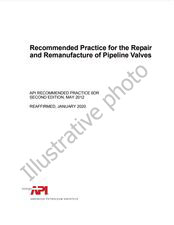We need your consent to use the individual data so that you can see information about your interests, among other things. Click "OK" to give your consent.

API RP 2217A-ed.5
Safe Work in Inert Confined Spaces in the Petroleum and Petrochemical Industries
Translate name
STANDARD published on 1.7.2017
The information about the standard:
Designation standards: API RP 2217A-ed.5
Publication date standards: 1.7.2017
SKU: NS-1140076
The number of pages: 34
Approximate weight : 102 g (0.22 lbs)
Country: American technical standard
Category: Technical standards API
Annotation of standard text API RP 2217A-ed.5 :
API RP 2217A, 5th Edition, July 2017 - Safe Work in Inert Confined Spaces in the Petroleum and Petrochemical Industries
This Recommended Practice provides guidance for safely entering and working within and near confined spaces that have inert atmospheres. API 2217A applies to confined spaces that have been intentionally purged with an inert gas until:
- — the oxygen level in the vapor space is too low to support combustion, and
- — any gases in or at the point of discharge from the confined space are deficient in oxygen such that the mixture is not flammable.
Typical inert entry work in the petroleum and petrochemical industry includes, but is not limited to work to service or replace catalyst in reactors and work in confined spaces where the flammable or toxic atmosphere cannot be removed or made safe by another method (such as atmospheric ventilation).
We recommend:
Technical standards updating
Do you want to make sure you use only the valid technical standards?
We can offer you a solution which will provide you a monthly overview concerning the updating of standards which you use.
Would you like to know more? Look at this page.



 Cookies
Cookies
